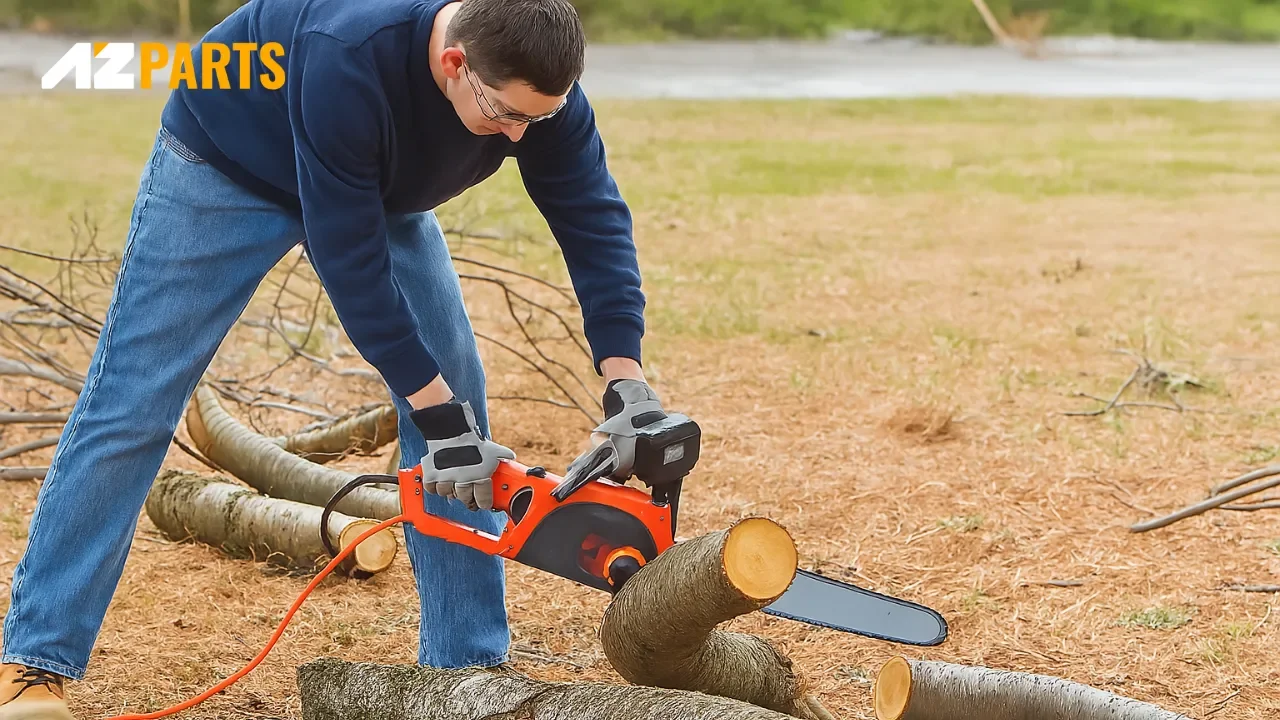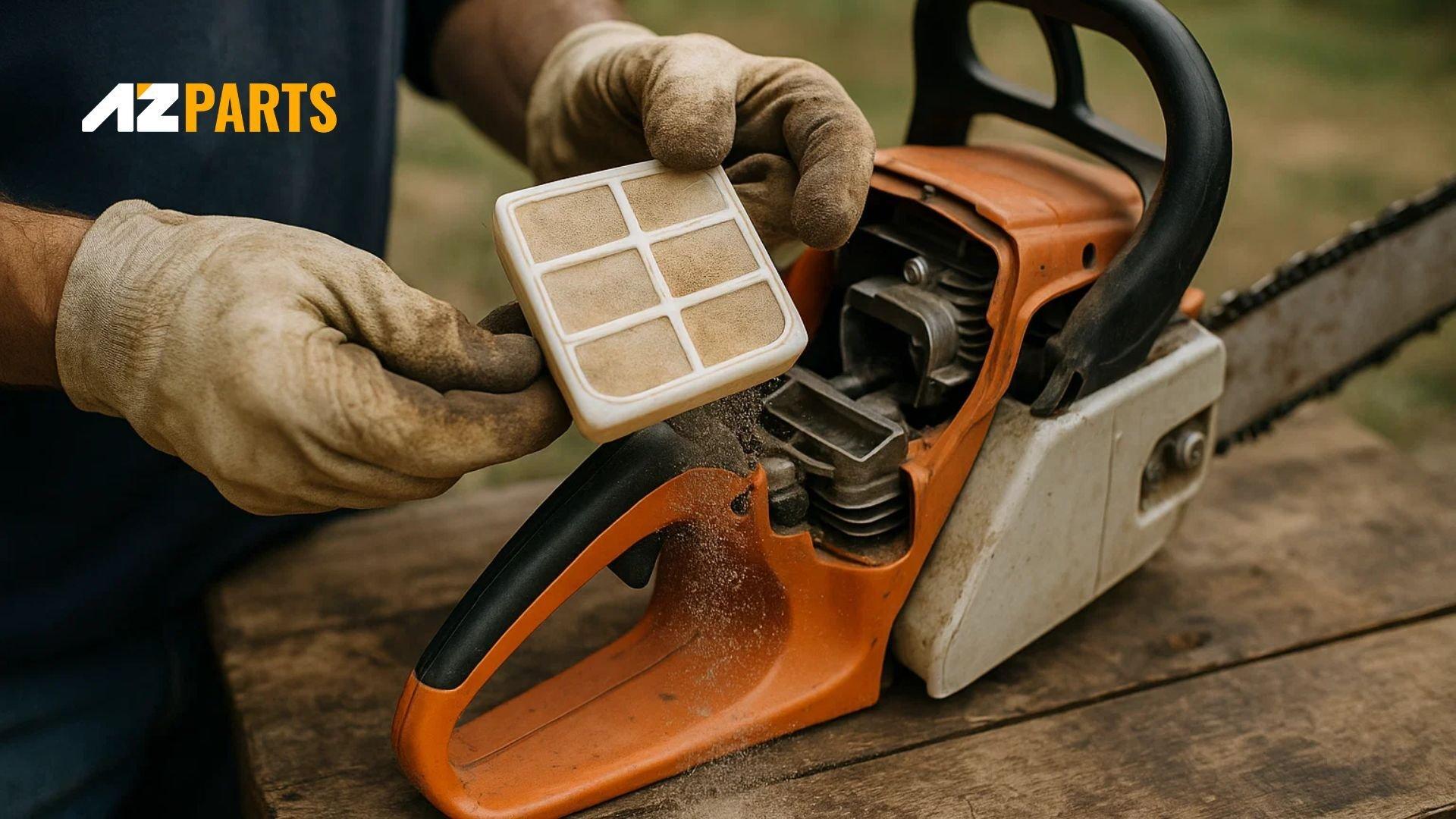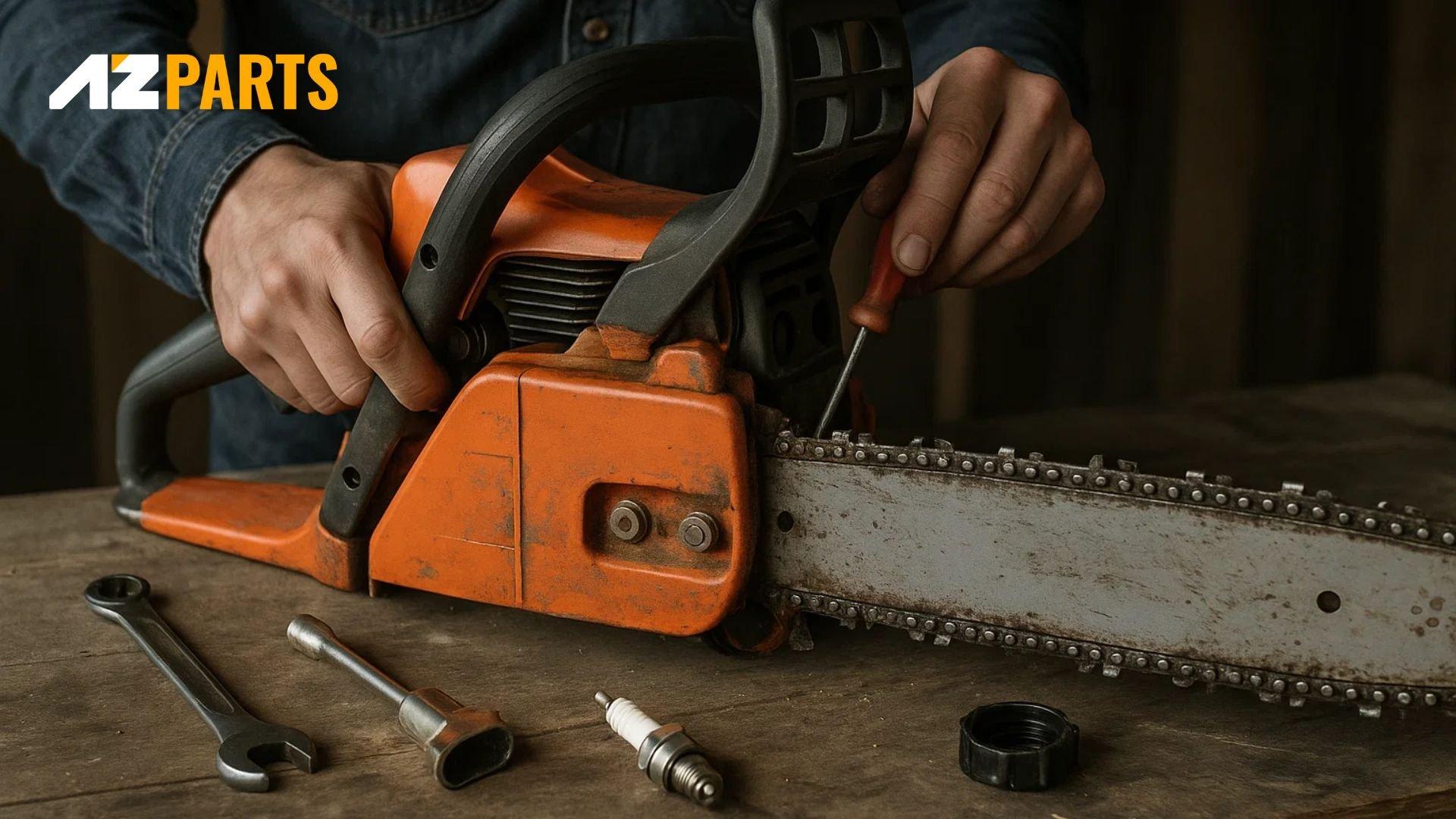Repair help
Essential Chainsaw Maintenance Tips for Longer Life
AZparts Team
Updated on July 31, 2025
7 min read
A chainsaw is a powerful and essential tool for tasks ranging from cutting firewood to tree maintenance. However, without proper maintenance, it can quickly wear out, become less efficient, and pose safety risks. Keeping a regular maintenance schedule not only extends the lifespan of your chainsaw but also ensures user safety. In this article, AZParts shares simple yet effective chainsaw maintenance tips that you can easily do at home.

1. Maintenance Routine by Frequency
1.1 Every Time You Use Your Chainsaw
Inspecting and maintaining your chainsaw after each use is crucial for safe operation and prolonged tool life. Here are the key tasks to perform:
- Check chain tension and sharpness: Ensure the chain is neither too loose nor too tight, and keep the teeth sharp for safe and efficient cutting.
- Check bar oil level: Refill if necessary to keep the chain and bar lubricated, preventing wear and overheating.
- Clean bar groove and oil holes: Remove sawdust and debris from the groove and oil holes to ensure proper oil flow.
- Ensure all safety features are functional (chain brake, throttle lock, etc.): Make sure safety components are in good working order before operation.
1.2 Weekly or After Heavy Use
- Sharpen the chain teeth and file the depth gauges: Keeps the chain sharp and ensures proper cutting depth, preventing kickback or uneven cuts.
- Clean or replace the air filter (for gas-powered chainsaws): Removes dust buildup so the engine gets clean air for stable performance and fuel efficiency.
- Inspect for loose screws, bolts, or damaged parts: Tighten anything that’s loose and replace worn components to ensure safe operation.

Inspecting and maintaining your chainsaw weekly is crucial for safe operation (Source: AZParts)
1.3 Monthly or Seasonal Maintenance
- Clean the cooling fins and spark arrestor (for gas chainsaws): Helps the engine cool effectively and reduces the risk of overheating or fire.
- Replace the spark plug if needed: A clean, functioning spark plug ensures quick starts and optimal fuel combustion.
- Check the guide bar for uneven wear: Rotate the bar and inspect for uneven wear to prevent chain misalignment or premature damage.
- Inspect battery contacts (for cordless chainsaws): Keep contacts clean and rust-free for stable power supply during use.
2. Deep-Dive: Chainsaw Maintenance
2.1 How to Sharpen Cutting Teeth
The cutting teeth on a chainsaw chain are the parts that come into direct contact with wood, so keeping them sharp is essential for both performance and safety. Sharpening should be done regularly, especially if you notice the saw cutting slower, requiring more force, or producing smoke.
Tools needed: A round file matching your chain size (typically 4mm, 4.8mm, or 5.5mm), a chain clamp or vise, and protective gloves.
Sharpening steps:
- Secure the chainsaw on a workbench or in a vise.
- File at the recommended angle (usually 25–35 degrees) with smooth, consistent strokes without excessive pressure.
- File each tooth the same number of strokes (e.g., 4–5) to maintain balance.
- After one side is done, rotate the saw or change your angle to file the other side.
- Visually inspect for even length and sharpness across all teeth.

Keeping the cutting teeth sharp is essential for both performance and safety (Source: AZParts)
2.2 How to File Depth Gauges
Depth gauges (also known as rakers) sit in front of each cutting tooth and control how much wood each tooth cuts. If too high, the chain will barely cut; if too low, the chain bites too deep, causing kickback and rough operation.
Tools needed: A flat file and depth gauge guide.
Filing steps:
- Place the gauge guide over the chain so the depth gauge sticks out through the guide slot.
- If it’s too high, file it down gently with a flat file until it’s level with the guide.
- Smooth the edges slightly after filing to prevent wood scratching.
- Check and adjust the depth gauges every 2–3 sharpening sessions.
2.3 Lubrication Best Practices
The bar and chain lubrication system reduces friction, cools the chain, and extends the life of the guide bar and chain. Running a chainsaw without proper oiling can lead to burnt chains, worn bars, and serious damage.
Oil type: Always use chainsaw-specific bar and chain oil. Do not use motor oil or used oil.
Regular checks:
- Before each use, check the oil level in the reservoir.
- After starting the saw, verify oil is reaching the bar by holding the tip near a light surface (like white wood) and looking for oil splatter.
Cleaning routine:
- Regularly clean the bar groove and oil holes to ensure even oil distribution.
- Check for clogging, cracks, or worn edges on the bar, and replace if needed.

Running a chainsaw without proper oiling can lead to burnt chains, worn bars, and serious damage (Source: AZParts)
3. Special Maintenance by Chainsaw Type
3.1 Gas Chainsaw Maintenance
Gas-powered chainsaws are a popular choice for heavy-duty outdoor tasks due to their powerful engines and ability to run continuously. However, because they use internal combustion engines, they require more frequent and detailed maintenance than other types.
- Make sure to regularly check and refill the bar and chain oil to prevent dry cutting, which can wear out the bar and chain.
- Clean the air filter every few uses to ensure clean airflow and keep the engine from choking during extended use.
Also, the spark plug is a component that tends to wear down over time. Inspect it regularly and replace it if there’s noticeable carbon buildup or black burn marks. Cleaning the cooling fins and spark arrestor will help prevent overheating and reduce the risk of fire.
Crucially, always use the correct fuel mix (gasoline and two-stroke oil) as recommended by the manufacturer. If you won’t use the saw for a while, start it up occasionally to prevent the carburetor from gumming up.
3.2 Corded Electric Chainsaw Maintenance
Corded electric chainsaws are ideal for semi-professional users or homeowners, thanks to their compact size, low emissions, and ease of use. To ensure safe operation:
- Regularly inspect the power cord, plug, and switch. If you notice any cuts, frays, or loose connections, replace them immediately to avoid electrical hazards.
- Clean the body and air vents frequently to prevent dust buildup, which can cause the machine to overheat.
Lubricating the bar and chain is just as important, especially since high-speed motors generate more friction. During use or storage, avoid letting the power cord become overstretched, tangled, or snagged on sharp edges, as this can shorten its lifespan or cause sudden failure. Always store the tool in a dry area to prevent electrical leakage and internal corrosion.

Corded Electric Chainsaw Maintenance (Source: AZParts)
3.3 Cordless Chainsaw Maintenance
Battery-powered chainsaws are favored for their portability and versatility in different environments. However, their battery packs can wear out quickly if not properly maintained.
- Always use the correct charger and battery specified by the manufacturer to avoid damage or risk of fire.
- Charge the battery when it reaches around 20–30% instead of letting it fully drain—this helps extend its lifespan and maintain consistent performance.
Clean the contact points between the battery and tool regularly to ensure uninterrupted power transfer. After use, remove the battery if you don’t plan to use the saw right away to prevent self-discharge. Store the battery in a cool, dry place, away from direct sunlight and extreme temperatures. If you notice signs of swelling, leakage, or overheating during charging, stop using the battery immediately and replace it for safety.

Cordless Chainsaw Maintenance (Source: AZParts)
4. Safety is Maintenance Too
Ensuring safety is not just important during chainsaw operation but also plays a vital role in the maintenance process. Here are essential practices you should follow:
Wear proper protective gear before each use:
- A helmet with a face shield or protective goggles
- Non-slip gloves
- Chainsaw chaps or cut-resistant clothing
- Safety boots with thick soles and anti-slip grip
Organize important documentation:
- Keep the user manual and warranty card in a safe place
- Record maintenance dates in a logbook to track the machine’s condition
Store the chainsaw properly:
- Store it in a dry, well-ventilated area away from moisture
- Keep it away from heat sources, fuel, or flammable materials
- Always store it out of reach of children
Following these safety and storage guidelines not only protects you during operation but also helps extend the lifespan and performance of your chainsaw.
Proper and regular chainsaw maintenance not only ensures safe operation but also significantly extends the lifespan of each component.
Whether you're using a gas-powered, corded electric, or cordless chainsaw, it’s essential to perform routine inspections, cleaning, and part replacements. When it's time to replace Chainsaw Parts, always choose high-quality, compatible components to maintain cutting performance and reduce the risk of damage. A well-maintained chainsaw is a reliable partner for any forestry task or home trimming job.
Learn more about other chainsaw's mantaining tips:
Contact Info
Address: 8 The Green, Ste A, Dover, Delaware 19901-3618, United States
Email: support@azparts.com
chainsaw
Further Reading
Further Reading





